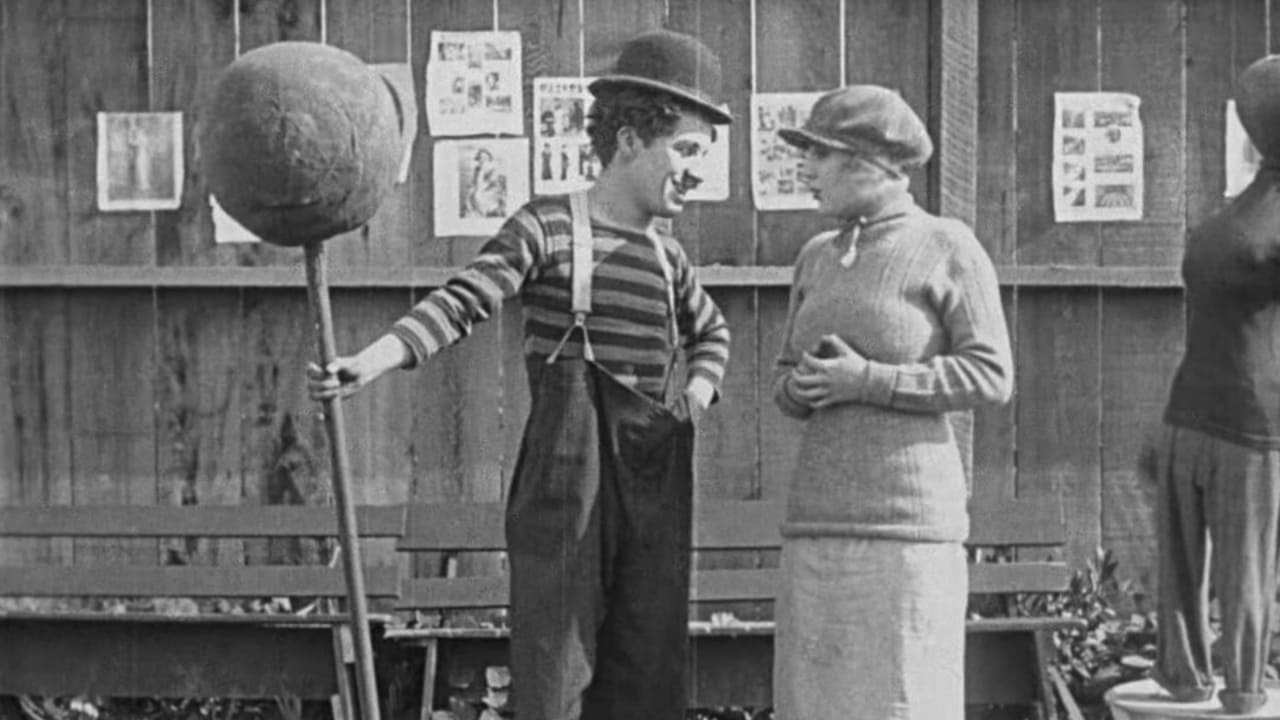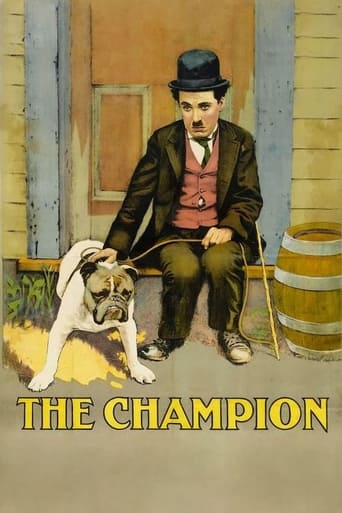

Chaplin was certainly the champion of silent films and was rapidly becoming well known in early 1915 when he edited, wrote, directed, and starred in The Champion. Chaplin plays a hapless guy with a dog, who still retains its dignity even in desperate straits. Chaplin seasons the stubborn dog's sausage; otherwise, it appears the dog refuses to eat. They happen upon a local fighter needing a sparring partner where Chaplin gets the brilliant idea of utilizing a horseshoe in his boxing glove in order to even the odds. Chaplin becomes invincible and later secures a match with a champion. The championship boxing match predates the one in City Lights by over 15 years, but Chaplin is magnificent dancing around the ring as the champ tries in vain to put him away. The referee takes as much of a beating as the fighters in the ring. This is pure slapstick fun with just enough plot to balance the film, unlike most other Chaplin films up to this time. Edna Purviance is Chaplin's love interest in their second film together. Ben Turpin appears as an obnoxious vendor. The silent screen giant of westerns Bronco Billy Anderson is the enthusiastic man in the audience. Warner Brothers director of 1930's and 1940's films Lloyd Bacon appears as one of the sparring partners. **1/2 of 4 stars.
... View MoreThis is one of 5 Chaplin that are on the first DVD of Chaplin's Essanay Comedies. In general, compared to volume 2, the shorts on volume 1 aren't as well-made--because the DVDs are arranged chronologically. Chaplin's skill as a film maker and actor appeared to improve through his stay with Essanay Studios.This short is not great, but compared to the previous Essanay shorts, it is a major improvement. That's because this short is more like a mini-movie and is very plot-driven--something ALL great Chaplin shorts have in common. The final boxing sequence is funny but makes no sense--just turn off your brain and enjoy.By the way,...I like the dog in the film. Dogs like this are cool.
... View MoreA comedy in three acts, this Chaplin short depicts his tramp as a somewhat more sympathetic character than many of his other films from this period. The tramp's impoverished status is played up here more than in some of his other Essanay films, and it strengthens both his character and the story as a result. Finding a lucky horseshoe outside a gym advertising for sparring partners 'who can take a punch', Charlie decides to give it a go. The horseshoe is put to predictable use and Chaplin suddenly finds himself up against the hulking Bob Uppercut (Bud Jamison). Chaplin would return to the ring in CITY LIGHTS and, while the fight sequence here comes nowhere near to the brilliance of that film's prize fight, it is still an entertaining bout that forms the highlight of the film. Edna Purviance appears once more, and Chaplin acknowledges the audience (and, perhaps, media speculation about their off-screen relationship) when he lifts a beer jug in front of their faces as they kiss. This is one of Chaplin's better early efforts.
... View MoreLike so many of Charlie Chaplin's early films The Champion has been subjected to a lot of tampering over the years. Depending on which print you see, the tough guy Charlie knocks out might be named Spike Dugan or Spike Henessy, his hefty opponent in the ring might be identified as Young Hippo or Bob Uppercut, leading lady Edna Purviance's presence during the training sessions may or may not be explained (in some editions she's identified as the trainer's daughter), Charlie's encounter with two cops might be deleted, and, all told, the film's running time could be anywhere from twenty minutes to as little as nine or ten. It's appalling what latter-day distributors have done to Chaplin's work; movies are renamed, scenes are rearranged or chopped out, and jokey title cards are added which are often unfunny, inappropriate and/or in poor taste. And on top of all that deliberate abuse the inevitable ravages of time and heavy usage have taken a toll on the quality of the prints themselves. Happily, however, and despite the rough treatment it has sustained, The Champion stands as one of Chaplin's funniest and most satisfying early comedies. The film boasts lots of sure-fire gags, colorful supporting players, and an especially vigorous and winning performance from the leading player himself.During his apprenticeship at Keystone in 1914 Chaplin learned the rudiments of filmmaking from Mack Sennett, who liked his comedies low and fast. Thus, in his earliest movies Chaplin is concerned only with action and gags, and doesn't seem to care whether the viewer likes his character or not; sometimes he's an out-and-out rotter. But with this new series for the Essanay company Chaplin learned, first, to slow down a little and let things unfold as they may. More importantly, he learned to develop a sympathetic character viewers could care about.The opening of The Champion shows Charlie sitting on a stoop with his only friend, an endearingly ugly bulldog named Spike, as they eat a meal. Charlie offers a sausage to Spike who, amusingly, chooses to eat only after the sausage has been properly seasoned. It's a charming scene and a leisurely one, and it sets an agreeable tempo. By the time the sequence is over, whether we've seen Charlie before or not, we like this poor guy and his ugly dog, and we're rooting for them. When Charlie decides to try his luck as a boxer he even manages to retain our sympathy when he employs less-than-ethical means to knock out his foe.Later, we're troubled when Charlie appears to flirt with the idea of accepting a bribe from a crooked gambler, but ultimately the crook gets what he deserves and Charlie is more The Good Guy than ever. This sequence, in some respects, is the funniest in the entire film. Gambler Leo White is hilariously hammy, and Charlie peppers us with gags using every available prop: the paper money he grips in his mouth, the gun that points every which way, and even Leo White's villainous mustache, which Charlie reaches over and twirls one step ahead of the villain.Everything builds towards the climactic battle. Chaplin fans taking the long view might regard this as a dry run for the big fight in City Lights, made in 1931, but for my money the boxing match in The Champion can hold its own as a great sequence in its own right. In addition to being well staged and beautifully timed, the scene features several notable participants silent film buffs will recognize. Charlie's tubby opponent in the ring is character actor Bud Jamison, at the beginning of a 30-year career supporting just about every prominent comedian of the era. In the stands meanwhile are two prominent players of the day, G. M. "Broncho Billy" Anderson and Ben Turpin. Anderson was among the very first Western stars, and also happened to be a co-founder of the Essanay company, producers of this film. Therefore Anderson was in effect Chaplin's boss, and his cameo (as a highly enthusiastic spectator) can be seen as something of a good-natured inside joke. Ben Turpin, on the other hand, had co-starred with Chaplin in his two previous comedies, but it's said that the two men didn't get along, and they went their separate ways after this point. Turpin is granted a very brief bit as a peanut vendor in the stands during the bout, clambering over spectators before he is bodily thrown out -- out of the stands, out of the film, and, in effect, out of Chaplin's orbit.In any event, the fight makes for a funny and exciting finale, and it provides Spike the dog with one last moment of screen immortality. (Sadly, the dog was struck and killed by a car shortly after this movie was completed.) For Spike's co-star, The Champion was not only a vast improvement over his earlier work, but the first of many classic comedies.
... View More